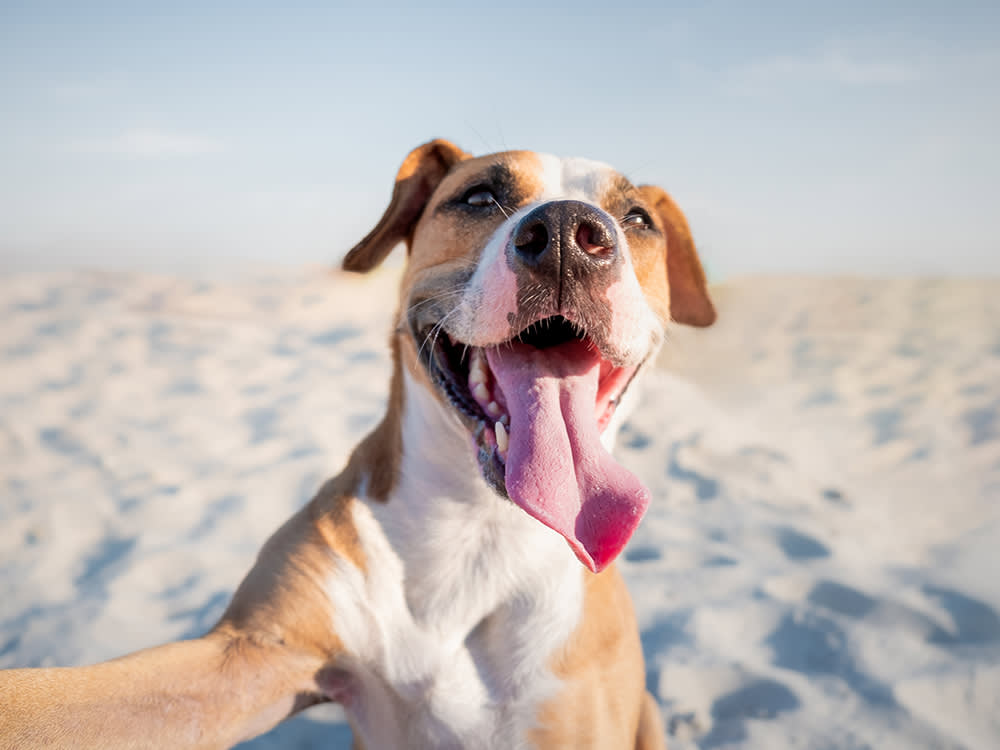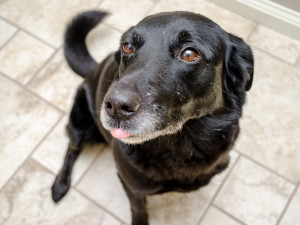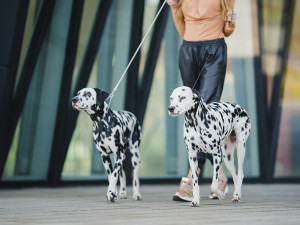What Are You Smiling At?
There’s a big difference between a dog smiling and showing their teeth
One of my favourite consultations involved a family who was worried about how their beloved Golden Retriever was ‘showing his teeth’ to their new baby. They feared that this behaviour – which happened whenever they brought their daughter into the living room after a nap, when he first saw her each morning, and when they came home with her after an absence – was aggressive.
Because the teeth showing was always in greeting and because their dog seemed about as threatening as a butterfly, I suspected that the dog was smiling, but I needed to know for sure (a baby’s safety depended on my assessment of the situation). I had the family step into the corridor with the baby for a few minutes, then return to my office. That’s when I saw it: a friendly smile by a friendly dog. It was accompanied by a loose body, a gentle but enthusiastic tail wag, a relaxed face and what I can only describe as an adoring gaze. And, just as when humans do it, his smile involved showing some teeth.
Get (totally free) deals for food, treats, accessories, tech and way more pet parenting must-haves.
Smiling vs showing teeth
What most of us call a dog smile is really a grin – a happy, open-mouthed face of a jolly dog. In this ‘happy grin’ kind of smile, which can last for minutes, the lower jaw hangs open and the corners of the lips are pulled back in a relaxed way. Sometimes the tongue hangs out, or is at least visible inside the mouth. Though the bottom teeth often show, the top teeth aren’t likely to. The second type of smile (the one discussed above) is a retraction of the lips that reveals the top and usually the bottom teeth as well. Because it resembles an aggressive expression called a ‘tooth display’, it can freak people out. However, this kind of smile has absolutely nothing to do with aggression. In fact, it’s a social expression.
These smiles happen quickly and are subtle. The upwards movement of the lips away from the teeth is often slight, and the retraction rarely lasts more than a second. The combination of minimal movement and speed makes it a challenge to capture them photographically. You have to be at exactly the right angle and height, which is difficult when a dog is moving around, often wagging not just the tail, but much of the body, as is so often the case when dogs smile.
Tooth displays, on the other hand, are usually performed by a dog who’s fairly stiff and still in both body and face. The showing of the teeth proceeds more slowly, and the expression can last for several seconds or more. Tooth displays are often an indication that a dog has been pushed past their comfort zone, perhaps by the approach or touch of another dog or a person, when they have a treasured object, or when they’re exhausted or in pain and want to be left alone.
Why dogs smile
Whenever a dog smiles in this fleeting, friendly, social way, I’m delighted. In my opinion, it reveals many positive qualities about that dog, and about the relationship between the dog and the recipient of the smile. Smiling dogs tend to be social, affiliative and loving. That said, I’m not aware of any scientific studies that explore the meaning and context of such smiles. So, I base this opinion on my own experience with smiling dogs, as well as discussions with other dog trainers and behaviourists over the years. Smiles are often given when greeting people the dog adores, especially if the dog hasn’t seen the person for some time. The smiles seem to indicate that the dog is over the moon about the reunion, and about the opportunity to greet the person.
I recently discussed what animal behaviourists call ‘smiles’ with Chelse Wagner, a certified behaviour consultant and dog trainer at Dog’s Best Friend Trainingopens in new tab. Wagner pointed out that while dogs displaying a smile tend to have loose bodies, they will often hold their ears back and keep their body lower to the ground; this can make them seem ambivalent or conflicted, rather than happy.
Smiling dogs are mimicking us
It has been suggested that dogs who smile learn it from humans. The action of smiling is very common among primates, including humans, and it is highly possible that dogs are copying us. This implies that dogs who smile have good social skills, which fits with my experience. I cannot think of a dog I have seen smile who is not social. Nor can I think of any dogs I’ve seen smile who were prone to arousal or getting out of control in play, greetings or other social settings.
If dogs do indeed learn to smile from people, then that means they have a strong connection to us and are capable of mimicking our behaviour. It also accounts for the smile’s vaguely awkward presentation – kind of like kids who are asked to smile for a photo but haven’t figured out how to do it naturally yet.







